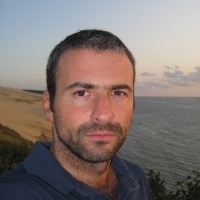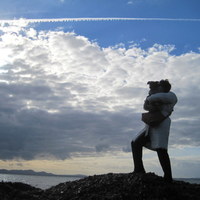Diego Salvadori (<diego.salvadori[at]unifi.it>) è Ricercatore in Letterature Comparate presso il il Dipartimento FORLILPSI dell’Università di Firenze. Ha conseguito nel 2019 l’ASN a professore associato per il SSD L-FIL-LET/14. Si occupa di ecocritica, studi di genere, scritture autobiografiche e critica della ricezione. È membro del Consiglio Direttivo dell’Associazione per la Memoria e la Scrittura delle Donne ‘Alessandra Contini Bonacossi’, nonché co-redattore de «il Portolano» e «Symbolon». Per quanto concerne i rapporti tra letteratura e ambiente, ha dedicato gran parte delle sue ricerche alla scrittura di Luigi Meneghello ("Il giardino riflesso", FUP 2015; "La biosfera e il racconto", FUP 2017), per poi concentrarsi sulle scritture al femminile (Sylvia Plath, Latife Tekin), la letteratura per l’infanzia e per ragazzi (Idolina Landolfi), i rapporti tra paesaggio e corpo (Giovanni Arpino), raffigurazioni del regno animale (Claudio Magris). Ha realizzato e gestisce la banca dati "Dove/nondove. Il parco virtuale", volto a repertoriare le narrazioni sui luoghi presenti nella letteratura al femminile. Tra le sue ultime pubblicazioni, si segnalano "Camille Mallarmé. La scrittura senza volto" (Florence Art Edizioni 2019) e "L’atlante di Claudio Magris" (Pàtron 2020). Nel 2021, ha curato, per la Rizzoli, la riedizione di "Jura" di Luigi Meneghello. Ha curato la bibliografia del Meridiano "Opere. 2" di Claudio Magris.
Diego Salvadori (<diego.salvadori[at]unifi.it>) teaches Comparative Literature at FORLILPSI Department, University of Florence. He has been qualified as associate professor in Comparative Literature by the Italian Ministry of Research and Education. His current researches include Literary Theory, ecocriticism and Gender Studies. He's in the scientific board of "Memoria e Scrittura delle Donne" (Firenze University Press). His most recent publication is "L'atlante di Claudio Magris" (Pàtron 2020).
----
Diego Salvadori (<diego.salvadori[at]unifi.it>) teaches Comparative Literature at FORLILPSI Department, University of Florence. He has been qualified as associate professor in Comparative Literature by the Italian Ministry of Research and Education. His current researches include Literary Theory, ecocriticism and Gender Studies. He's in the scientific board of "Memoria e Scrittura delle Donne" (Firenze University Press). His most recent publication is "L'atlante di Claudio Magris" (Pàtron 2020).
----
less
Related Authors
Jill Burke
University of Edinburgh
Andrea Peto
Central European University
John Clark
Loyola University New Orleans
Serpil Oppermann
Kapadokya Üniversitesi
David Seamon
Kansas State University
Caroline J . Tully
University of Melbourne
Paolo Zublena
Università degli Studi di Genova
Julia Hell
University of Michigan
Christy Wampole
Princeton University
Eva Botella-Ordinas
Universidad Autónoma de Madrid
InterestsView All (23)










Uploads
Books by Diego Salvadori
In Luigi Meneghello’s work, literary representations of the mineral world play a deconstructive role, in that they authorize unprecedented and transversal readings aimed at unlocking the writer’s material and scientific imagery. Meneghello quite literally seems to have ‘stratified’ his creative work through using this imagery, from the lithogenesis of writing to the semantics of the crystal, petrifying reveries, and the effusive magma of language. The líthos is used as a ‘probe’, a hermeneutic sounding device through which to investigate cultural systems, the sedimentation of collective memory, and the role of writing itself, and it functions as a privileged access key to the author’s poetics.
Nipote del poeta Stéphane, moglie di Paolo Orano, amica intima di Eleonora Duse e Gabriele D’Annunzio, nonché traduttrice di Pirandello in Francia, Camille Mallarmé si colloca in uno dei momenti più delicati e intensi della Storia primonovecentesca per poi uscirne sconfitta, al pari di una personalità apolide e a tratti ‘scomoda’.
Quel che resta è una scrittura senza volto, di cui Diego Salvadori segue l’evoluzione discontinua e incerta, ripercorrendo in maniera inversa le tappe di un volontario sfiguramento, attraverso l’analisi di documenti inediti e d’archivio, ma soprattutto guardando alla produzione letteraria della scrittrice: dal romanzo sentimentale alla narrativa per l’infanzia, per poi approdare all’autobiografismo latente.
Nell’opera di Luigi Meneghello, la rappresentazione del mondo vegetale rimanda a un sottotesto di immagini e simboli: una rete di isotopie botaniche che, nel farsi sistema, autorizza una lettura alternativa e inedita. Dalle pagine di Libera nos a malo (1963), fino alle ‘carte postume’ de L’apprendistato (2012), «l’inframondo verdastro» diviene il punto di partenza per ricostruire una biosfera letteraria, attraversata sempre da un duplice movimento: memoria intertestuale e interazione continua fra lingua italiana, lingua inglese e dialetto vicentino. Il ‘giardino riflesso’ di Meneghello si rivela così in tutta la sua valenza semantica e fa luce su un tema che risulta essere di grande complessità e un oggetto di particolare interesse per l’ecocritica letteraria.
[EN]
In Luigi Meneghello’s works, representation of the vegetable kingdom refers to a subtext of images and symbols, which leads up to an alternative way of reading. In an ecocritical perspective, plants become the starting point of a literary biosphere, animated by two movements: intertextuality and interaction between English, Italian language and dialect.
Translated books by Diego Salvadori
ARTICLES by Diego Salvadori
stands as a significant work deserving of scholarly attention. This article
presents a close reading of the text, focusing on its underlying ecopedagogical substratum and exploring the intertextual, figurative, and cinematic references embedded within the narrative. Landolfi’s portrayal of I litosauri not only offers a captivating story, but also serves as a poignant reflection on ecological concerns and human-nature relationships. By delving into the intricacies of Landolfi’s prose and uncovering its rich intertextual tapestry, this analysis seeks to shed light on the literary merits of I litosauri, aiming to reclaim its place in contemporary discourse in children and young adult literature.
contribution intends to carry out investigations on the representation of the sewage system as an 'apparatus' not only taking into account the intertextual tangencies (Hugo, Zola, Sue), but equally applying the theoretical framework of Material Ecocriticism. In the case of It, the sewers become an urban body: the space of an irreversible contamination that has the opportunity to make explicit an 'ecophobic' tension and, likewise, carry forward a parallel narrative on the management of wastewater and the consequent pollution of the ecosystems linked to it .
Looking at the interviews released by Luigi Meneghello during his activity as a writer, this paper intends to analyze the authorial attitude to the practice of the interview, ready to resolve in a diffidence towards the dialogical exchange and, specifically , the shift from orality to writing. Nonetheless, the interviews with Luigi Meneghello become hermeneutic pick for a transversal reading of his production, based on thematic recursions which for this reason illuminate his macrotext.
In Luigi Meneghello’s work, literary representations of the mineral world play a deconstructive role, in that they authorize unprecedented and transversal readings aimed at unlocking the writer’s material and scientific imagery. Meneghello quite literally seems to have ‘stratified’ his creative work through using this imagery, from the lithogenesis of writing to the semantics of the crystal, petrifying reveries, and the effusive magma of language. The líthos is used as a ‘probe’, a hermeneutic sounding device through which to investigate cultural systems, the sedimentation of collective memory, and the role of writing itself, and it functions as a privileged access key to the author’s poetics.
Nipote del poeta Stéphane, moglie di Paolo Orano, amica intima di Eleonora Duse e Gabriele D’Annunzio, nonché traduttrice di Pirandello in Francia, Camille Mallarmé si colloca in uno dei momenti più delicati e intensi della Storia primonovecentesca per poi uscirne sconfitta, al pari di una personalità apolide e a tratti ‘scomoda’.
Quel che resta è una scrittura senza volto, di cui Diego Salvadori segue l’evoluzione discontinua e incerta, ripercorrendo in maniera inversa le tappe di un volontario sfiguramento, attraverso l’analisi di documenti inediti e d’archivio, ma soprattutto guardando alla produzione letteraria della scrittrice: dal romanzo sentimentale alla narrativa per l’infanzia, per poi approdare all’autobiografismo latente.
Nell’opera di Luigi Meneghello, la rappresentazione del mondo vegetale rimanda a un sottotesto di immagini e simboli: una rete di isotopie botaniche che, nel farsi sistema, autorizza una lettura alternativa e inedita. Dalle pagine di Libera nos a malo (1963), fino alle ‘carte postume’ de L’apprendistato (2012), «l’inframondo verdastro» diviene il punto di partenza per ricostruire una biosfera letteraria, attraversata sempre da un duplice movimento: memoria intertestuale e interazione continua fra lingua italiana, lingua inglese e dialetto vicentino. Il ‘giardino riflesso’ di Meneghello si rivela così in tutta la sua valenza semantica e fa luce su un tema che risulta essere di grande complessità e un oggetto di particolare interesse per l’ecocritica letteraria.
[EN]
In Luigi Meneghello’s works, representation of the vegetable kingdom refers to a subtext of images and symbols, which leads up to an alternative way of reading. In an ecocritical perspective, plants become the starting point of a literary biosphere, animated by two movements: intertextuality and interaction between English, Italian language and dialect.
stands as a significant work deserving of scholarly attention. This article
presents a close reading of the text, focusing on its underlying ecopedagogical substratum and exploring the intertextual, figurative, and cinematic references embedded within the narrative. Landolfi’s portrayal of I litosauri not only offers a captivating story, but also serves as a poignant reflection on ecological concerns and human-nature relationships. By delving into the intricacies of Landolfi’s prose and uncovering its rich intertextual tapestry, this analysis seeks to shed light on the literary merits of I litosauri, aiming to reclaim its place in contemporary discourse in children and young adult literature.
contribution intends to carry out investigations on the representation of the sewage system as an 'apparatus' not only taking into account the intertextual tangencies (Hugo, Zola, Sue), but equally applying the theoretical framework of Material Ecocriticism. In the case of It, the sewers become an urban body: the space of an irreversible contamination that has the opportunity to make explicit an 'ecophobic' tension and, likewise, carry forward a parallel narrative on the management of wastewater and the consequent pollution of the ecosystems linked to it .
Looking at the interviews released by Luigi Meneghello during his activity as a writer, this paper intends to analyze the authorial attitude to the practice of the interview, ready to resolve in a diffidence towards the dialogical exchange and, specifically , the shift from orality to writing. Nonetheless, the interviews with Luigi Meneghello become hermeneutic pick for a transversal reading of his production, based on thematic recursions which for this reason illuminate his macrotext.
"Esperienze Letterarie", 3, XL 2015 pp. 150-155